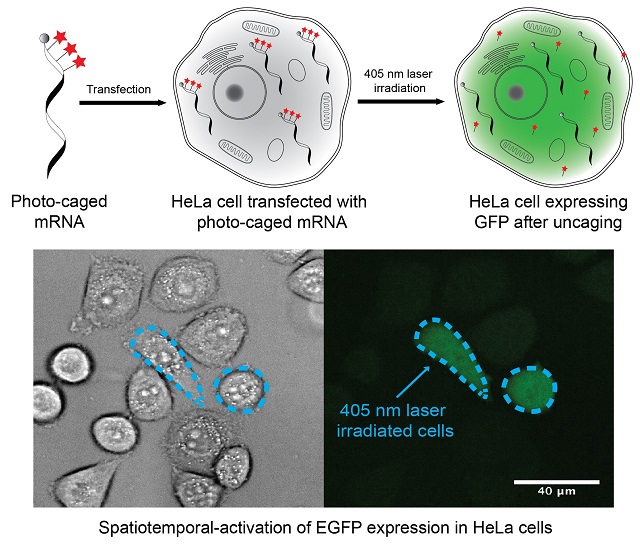
UC San Diego Chemists Use Light to Pinpoint Gene Expression
Published Date
By:
- Cynthia Dillon
Share This:
Article Content
Armed with skill, special tools and light, University of California San Diego Associate Professor Neal Devaraj and a group of his chemistry graduate students activated cellular gene expression with unique precision.
By modifying messenger RNA (mRNA)—a group of molecules that carries genetic information from DNA to ribosomes where specifications of gene expression occur—the chemists were able to precisely trigger gene expressions at a specific time and place using laser light. This novel technique will ease future studies of individual protein functions in cells or tissues at different stages of biological development.
The details of this study are published online in a recent issue of Angewandte Chemie.
Scientifically, manipulating gene expression is fundamental to basic research, biotechnology and the development of new therapies. And, according to Devaraj, Department of Chemistry and Biochemistry faculty member and principal investigator at the Devaraj Research Group at UC San Diego, the ability to regulate the translation of mRNA provides a unique way to control the function of novel mRNA-based therapeutics.
“mRNA has recently been widely studied as a drug for therapeutic applications,” confirmed Devaraj. “Compared to DNA-based gene therapy, in vivo expression of therapeutic proteins through the direct translation of mRNA offers much quicker response times and minimizes the risk of causing insertional mutagenesis (DNA mutations). Our mRNA translation regulation approach can greatly expand the toolbox of mRNA modification for therapeutic discoveries.”
Devaraj explained that the study required a dynamic combination of organic chemistry, molecular biology and cell biology. A basic explanation of the process is that scientists produced photo-reactive groups of chemicals using exposure to light and designed RNA sequences by cloning and mutating molecules. To obtain the modified mRNA—of the type that would express mammalian traits—the researchers conducted a variety of chemical reactions using enzymes.
“The obtained mRNA was transfected into cultured HeLa cells, and its translation activity was measured by fluorescence microscopy,” described Deveraj, adding that researchers involved in the project were able to learn different synthetic skills as well as molecular biology techniques.
“The most exciting part about chemical biology is that it requires knowledge and application of both chemical and biological techniques. By designing and chemically modifying biomacromolecules, we are able to artificially control different cellular pathways and develop novel techniques which can promote the development of both fundamental types of research and biotechnological applications,” said Devaraj.
The research was mainly conducted by UC San Diego graduate students Dongyang Zhang, Cun Yu Zhou and Kayla Busby. Former postdoctoral scholar Seth Alexander also contributed to the study. Funding was provided by the National Institutes of Health (grants R01 GM123285-01 and T32 GM112584-03 ) and the Army Research Office (grant W911NF-13-1-0383).
The Department of Chemistry and Biochemistry at UC San Diego, part of the Division of Physical Sciences, is committed to excellence in research, education and service. As part of that mission, it values and promotes equity, fairness and inclusion of diverse members.
Share This:
You May Also Like
Stay in the Know
Keep up with all the latest from UC San Diego. Subscribe to the newsletter today.



